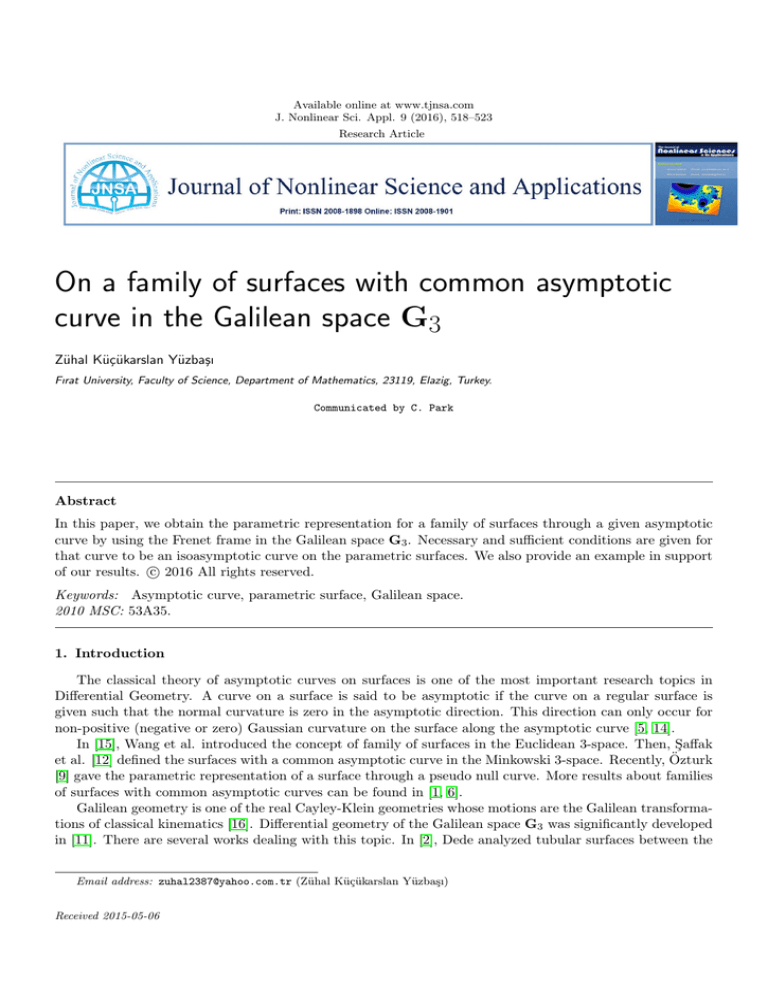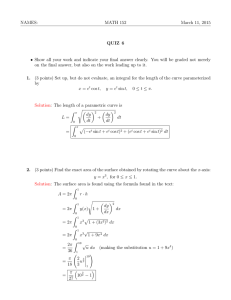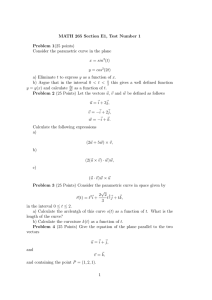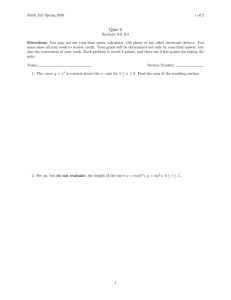
Available online at www.tjnsa.com
J. Nonlinear Sci. Appl. 9 (2016), 518–523
Research Article
On a family of surfaces with common asymptotic
curve in the Galilean space G3
Zühal Küçükarslan Yüzbaşı
Fırat University, Faculty of Science, Department of Mathematics, 23119, Elazig, Turkey.
Communicated by C. Park
Abstract
In this paper, we obtain the parametric representation for a family of surfaces through a given asymptotic
curve by using the Frenet frame in the Galilean space G3 . Necessary and sufficient conditions are given for
that curve to be an isoasymptotic curve on the parametric surfaces. We also provide an example in support
c 2016 All rights reserved.
of our results. Keywords: Asymptotic curve, parametric surface, Galilean space.
2010 MSC: 53A35.
1. Introduction
The classical theory of asymptotic curves on surfaces is one of the most important research topics in
Differential Geometry. A curve on a surface is said to be asymptotic if the curve on a regular surface is
given such that the normal curvature is zero in the asymptotic direction. This direction can only occur for
non-positive (negative or zero) Gaussian curvature on the surface along the asymptotic curve [5, 14].
In [15], Wang et al. introduced the concept of family of surfaces in the Euclidean 3-space. Then, Şaffak
et al. [12] defined the surfaces with a common asymptotic curve in the Minkowski 3-space. Recently, Özturk
[9] gave the parametric representation of a surface through a pseudo null curve. More results about families
of surfaces with common asymptotic curves can be found in [1, 6].
Galilean geometry is one of the real Cayley-Klein geometries whose motions are the Galilean transformations of classical kinematics [16]. Differential geometry of the Galilean space G3 was significantly developed
in [11]. There are several works dealing with this topic. In [2], Dede analyzed tubular surfaces between the
Email address: zuhal2387@yahoo.com.tr (Zühal Küçükarslan Yüzbaşı)
Received 2015-05-06
Zühal Küçükarslan Yüzbaşı, J. Nonlinear Sci. Appl. 9 (2016), 518–523
519
Galilean and Euclidean space. Dede et al. [3] studied parallel surfaces in the Galilean space. Ogrenmis et
al. [8] obtained characterizations of the helix for a curve in the Galilean space.
The starting point of our study is to express the parametric representation of the surface through a given
asymptotic curve in the Galilean space G3 . First, we obtain the necessary and sufficient conditions for the
given curve to be isoasymptotic on the parametric surface. After that, the family of parametric surfaces
with common asymptotic curve in the Galilean space G3 is defined. Finally, we give an example to illustrate
this family of surfaces.
2. Preliminaries
The Galilean space G3 is a Cayley-Klein space equipped with the projective metric of signature
(0, 0, +, +), given in [7]. The absolute figure of the Galilean space consists of an ordered triple {ω, f, I}
in which ω is the ideal (absolute) plane, f is the line (absolute line) in ω and I is the fixed elliptic involution of f .
A vector x = (x1 , x2 , x3 ) is called non-isotropic if x1 6= 0. All unit isotropic vectors are of the form
x = (1, x2 , x3 ) . For isotropic vectors we have x1 = 0.
Definition 2.1 ([13]). Let x = (x1 , x2 , x3 ) and y = (y1 , y2 , y3 ) be vectors in G3 . The Galilean scalar
product of x and y is given by
(
x 1 y1 ,
if x1 6= 0 or y1 6= 0
hx, yi =
x2 y2 + x3 y3 , if x1 = 0 and y1 = 0
Definition 2.2 ([13]). Let x = (x1 , x2 , x3 ) and y =
product x and y is defined by
0
x ∧ y = x1
y1
(y1 , y2 , y3 ) be vectors in G3 . The Galilean vector
e2 e3 x2 x3 .
y2 y3 Let r be an admissible curve of the class C∞ in G3 , parameterized by the invariant parameter u, given
by
r (u) = (u, f (u) , g (u)) .
Then the curvature κ (u) and the torsion τ (u) of the curve r can be given by
q
κ (u) = f 00 (u)2 + g 00 (u)2 ,
and
τ (u) =
det (r0 (u) , r00 (u) , r000 (u))
,
κ2 (u)
and the associated moving trihedron satisfies
t (u) = r0 (u) = (1, f 0 (u) , g 0 (u)) ,
r00 (u)
1
n (u) =
=
0, f 00 (u) , g 00 (u) ,
κ (u)
κ (u)
1
b (u) =
0, −g 00 (u) , f 00 (u) ,
κ (u)
where t, n and b are called the vectors of the tangent, principal normal and binormal of r (u) , respectively.
Frenet formulas are given by
0
t = κn,
n0 = τ b,
0
b = −τ n,
Zühal Küçükarslan Yüzbaşı, J. Nonlinear Sci. Appl. 9 (2016), 518–523
520
(see [10]).
The equation of a surface in G3 can be given by the parametrization
ϕ υ 1 , υ 2 = ϕ1 υ 1 , υ 2 , ϕ2 υ 1 , υ 2 , ϕ3 υ 1 , υ 2 , υ 1 , υ 2 ∈ R,
where ϕ1 υ 1 , υ 2 , ϕ2 υ 1 , υ 2 and ϕ3 υ 1 , υ 2 ∈ C3 ([11]).
3. Surfaces with common asymptotic curve in Galilean space G3
Let ϕ = ϕ (u, v) be a parametric surface on the arc-length parametrized curve r(u) in G3 . The surface
is defined by
ϕ (u, v) = r(u) + [x (u, v) t (u) + y (u, v) n (u) + z (u, v) b (u)] ,
(3.1)
L1 ≤ u ≤ L2 and T1 ≤ v ≤ T2 ,
(3.2)
where x (u, v) , y (u, v) and z (u, v) which are the values of the marching-scale functions indicate, respectively,
the extension-like, flexion-like and retortion-like effects, by the point unit through time v, starting from r(u),
{t (u) , n (u) , b (u)} is the frame associated with the curve r(u) in G3 , and the values of the marching-scale
functions are C 1 functions.
Our first aim is to obtain the necessary and sufficient conditions for the curve r(u) to be a parametric
and asymptotic curve on the surface.
Since r(u) is a parametric curve on the surface ϕ (u, v), there exists a parameter v0 ∈ [T1 , T2 ] such that
x (u, v0 ) = y (u, v0 ) = z (u, v0 ) = 0, L1 ≤ u ≤ L2 and T1 ≤ v ≤ T2 .
Moreover, the curve r(u) on the surface ϕ (u, v) is asymptotic iff the binormal b (u) of the curve r(u)
and the normal η (u, v0 ) of the surface ϕ (u, v) at any point on the curve r(u) are parallel to each other [4].
If the curve is both asymptotic and parametric on ϕ, then it is said to be isoasymptotic on ϕ.
Theorem 3.1. The curve r(u) is isoasymptotic on the surface ϕ (u, v) iff the following relations are satisfied:
x (u, v0 ) = y (u, v0 ) = z (u, v0 ) = 0,
(3.3)
− (1 + xu ) zv + zu xv = 0,
(3.4)
(1 + xu ) yv − yu xv 6= 0.
(3.5)
Proof. Let r(u) be a curve on the surface ϕ (u, v) in G3 . If r(u) is parametric curve on this surface, then
there exists a parameter v = v0 such that r(u) = ϕ (u, v0 ) , that is
x (u, v0 ) = y (u, v0 ) = z (u, v0 ) = 0.
The normal η (u, v) of the surface is given by
η (u, v) = ϕu × ϕv ,
where from (3.1),
ϕu = (1 + xu ) t + (kx + yu − τ z) n + (τ y + zu ) b,
and
ϕv = xv t + yv n + zv b.
Using (3.6), the normal η (u, v) can be written as
η (u, v) = [− (1 + xu ) zv + (τ y + zu ) xv ] n + [(1 + xu ) yv − (kx + yu − τ z) xv ] b,
(3.6)
Zühal Küçükarslan Yüzbaşı, J. Nonlinear Sci. Appl. 9 (2016), 518–523
521
and from (3.3) we get
η (u, v0 ) = [− (1 + xu ) zv + zu xv ] n + [(1 + xu ) yv − yu xv ] b.
Given that r(u) is asymptotic curve if and only if b (u) kη (u, v0 ), we obtain
− (1 + xu ) zv + zu xv = 0
and
(1 + xu ) yv − yu xv 6= 0,
which completes the proof.
The set of surfaces given by (3.1) and satisfying (3.3), (3.4) and (3.5) is called the family of surfaces
with common isoasymptotic in G3 . The marching-scale functions x (u, v) , y (u, v) and z (u, v) can be given
in two different forms:
Case 1. If we take
x (u, v) = a (u) X (v) ,
y (u, v) = b (u) Y (v) ,
(3.7)
z (u, v) = c (u) Z (v) ,
then the sufficient condition for which the curve r(u) is isoasymptotic on the surface ϕ (u, v) can be expressed
as
X (v0 ) = Y (v0 ) = Z (v0 ) = 0,
dY (v0 )
b (u) 6= 0,
6= 0,
dv
dZ (v0 )
c (u) = 0,
= 0,
dv
(3.8)
where a (u) , b (u) , c (u), X (v) , Y (v) and Z (v) are C 1 functions and a (u) , b (u) and c (u) are not identically
zero.
Case 2. If we take
x (u, v) = f (a (u) X (v)) ,
y (u, v) = g (b (u) Y (v)) ,
(3.9)
z (u, v) = h (c (u) Z (v)) ,
then the sufficient condition for which r(u) is an isoasymptotic curve on the surface ϕ (u, v) can be expressed
as
X (v0 ) = Y (v0 ) = Z (v0 ) = 0,
f (0) = g (0) = h (0) = 0,
dY (v0 )
6= 0, g0 (0) 6= 0,
b (u) 6= 0,
dv
dZ (v0 )
c (u) = 0,
= 0, h0 (0) = 0,
dv
where a (u) , b (u) , c (u), X (v) , Y (v) , Z (v) , f , g and h are C 1 functions and a (u) , b (u) and c (u) are
not identically zero.
Then, we get the marching-scale functions in (3.7) and (3.9) which are general for expressing surfaces
having a given curve as an isoasymptotic curve in G3 . Also, different types of marching-scale functions can
be chosen according to Theorem 3.1.
Zühal Küçükarslan Yüzbaşı, J. Nonlinear Sci. Appl. 9 (2016), 518–523
522
Example 3.2. Let r be parameterized by
r (u) = (u, sin u, cos u) .
It is easy to show that
t
n
b
= (1, cos u, − sin u) ,
= (0, − sin u, − cos u) ,
= (0, cos u, − sin u) ,
where κ = 1 is the curvature and τ = 1 is the torsion of the curve in G3 .
We will give the family of surfaces with this common isoasymptotic curve. If we choose
x (u, v) = 0 , y (u, v) = sin v and z (u, v) = cos v,
and v0 = 0 such that equation (3.8) is satisfied, a member of this family is obtained by
ϕ (u, v) = (u, sin u − sin v sin u + cos v cos u, cos u − sin v cos u − cos v sin u) .
(a)
(b)
Figure 1: (a) The curve r (u) , (b) A member of the family of surfaces having r(u) as an asymptotic curve
Acknowledgements:
The author thanks the referees and the editor for their suggestions and advice.
References
[1] E. Bayram, F. Güler, E. Kasap, Parametric representation of a surface pencil with a common asymptotic curve,
Comput. Aid. Design, 44 (2012), 637–643. 1
[2] M. Dede, Tubular surfaces in Galilean space, Math. Commun., 18 (2013), 209–217. 1
[3] M. Dede, C. Ekici, A. C. Çöken, On the parallel surfaces in Galilean space, Hacet. J. Math. Stat., 42 (2013),
605–615. 1
[4] G. E. Farin, Curves and surfaces for CAGD: A practical guide, Academic press, London, (2002). 3
Zühal Küçükarslan Yüzbaşı, J. Nonlinear Sci. Appl. 9 (2016), 518–523
523
[5] W. Klingenberg, A course in Differential Geometry, Springer, New York, (1978). 1
[6] C. Y. Li, R. H. Wang, C. G. Zhu, Parametric representation of a surface pencil with a common line of curvature,
Comput. Aid. Design, 43 (2011), 1110–1117. 1
[7] E. Molnar, The projective interpretation of the eight 3-dimensional homogeneous geometries, Beiträge zur algebra
Geom., 38 (1997), 261–288. 2
[8] A. Ögrenmiş, M. Ergüt, M. Bektaş, On the helices in the Galilean space G3, Iran. J. Sci. Tech., 31 (2007),
177–181. 1
[9] E. B. K. Özturk, A note on parametric surfaces in Minkowski 3-space, The Sci. World J., 2014 (2014), 6 pages.1
[10] B. J. Pavkovic, I. Kamenarovic, The equiform differential geometry of curves in the Galilean space G3, Glas.
Mat., 22 (1987), 449–457. 2
[11] O. Röschel, Die geometrie des Galileischen raumes, Forschungszentrum Graz, Mathematisch-Statistische Sektion,
Graz, (1985). 1, 2
[12] G. Şaffak, E. Bayram, E. Kasap, Surfaces with a common asymptotic curve in Minkowski 3-space, arXive, 2013
(2013), 10 pages. 1
[13] Ž. M. Šipuš, Ruled Weingarten surfaces in the Galilean space, Period. Math. Hung., 56 (2008), 213–225. 2.1, 2.2
[14] D. J. Struik, Lectures on classical differential geometry, Dover, New York, (1988). 1
[15] G. J. Wang, K. Tang, C. L. Tai, Parametric representation of a surface pencil with a common spatial geodesic,
Comput. Aid. Design, 36 (2004), 447–459. 1
[16] I. M. Yaglom, A simple non-Euclidean geometry and its physical basis, Springer-Verlag, New York, (1979). 1







